Amchitka's nuclear legacy
Feature story extras
Additional reading:
Long Shot, Milrow and Cannikin descriptions and historical videos.
What were the scientists on Amchitka in 2004 looking for?
Audio files:
Dave Barnes describes what happens during an underground nuclear blast.
Mark Johnson describes fortifications found on Amchitka Island.
Mark Johnson describes precautions against radioactivity levels.
Videos:
Long Shot, Milrow and Cannikin descriptions and historical videos.
Amchitka underwater studies videos
Photo galleries:
Gallery of the underwater studies at Amchitka
Gallery of the terrestrial studies at Amchitka
By Doug Schneider, Alaska Sea Grant College Program
February 2006
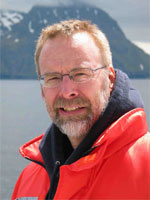
Mark Johnson is a professor of physical oceanography at the UAF School of Fisheries and Ocean Sciences.
Photo courtesy UAF School of Fisheries and Ocean Sciences.
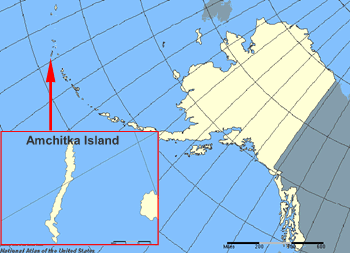
Lean, muscular and nearly seven feet tall, blonde haired oceanographer Mark Johnson leans across the rail of the research vessel Ocean Explorer and scans Amchitka Island’s emerald-green bluffs. He looks a bit like a Viking preparing to invade.
"It’s a beautiful place, no doubt about that," said Johnson, a professor of physical oceanography at the UAF School of Fisheries and Ocean Sciences. "I can’t wait to get ashore and look around."
But Johnson is no invader, and the Ocean Explorer is no Viking ship. However, an invasion of sorts did occur, albeit nearly 40 years ago. It was on this lonely outpost along the Aleutian Island chain, some 1,200 miles southwest of Anchorage, that the United States conducted three massive underground nuclear tests between 1965 and 1971. The largest--code-named Cannikin--exploded with a destructive power 400 times larger than the atomic bomb dropped on Hiroshima during World War II.
Today, Amchitka Island lies abandoned and eerily silent, save for the ever-present wind and pummeling rain. The buildings, roads and even an airstrip that once supported the nation’s ambitious underground nuclear testing program are gone. The three underground shafts--called Milrow, Long Shot and Cannikin--are entombed in concrete and obscured by encroaching tundra grasses. Atop Cannikin’s 6,000-foot shaft, a small sea salt-tarnished plaque commemorates the Nov. 6, 1971 nuclear explosion, the largest in U.S. history. It is the only official reminder of the firestorms unleashed here during the Cold War.
"I’m paraphrasing, but it says ’don’t dig here,’" Johnson said. "It’s funny to see that. I doubt that plaque will be there to warn people a thousand years from now."
Amchitka is now part of the Alaska Maritime National Wildlife Refuge, a nearly five million acre collection of islands and mainland seacoast stretching from Southeast through the Aleutian Islands north to the arctic coast.
But while the nuclear tests have ended, concern that the island may be leaking deadly radiation has lingered among Aleut Natives, fishermen, environmentalists and scientists. Aleuts, who have not lived on the island for decades, hope to someday return. Ensuring the island is safe from nuclear contamination is important for re-settlement efforts, and for the environment as well. The surrounding Bering Sea waters support some of the largest pollock, crab, salmon and cod fisheries in the world, and are home to millions of seabirds and thousands of marine mammals.
In 2004, Johnson brought a team of UAF scientists to Amchitka, not to plunder and pillage but to study and learn. Their task was to conduct the first comprehensive baseline study on nuclear fallout on the island since the Cold War. They hoped to learn whether radiation had spread from the blast sites and if it was leaking into the surrounding marine ecosystem.
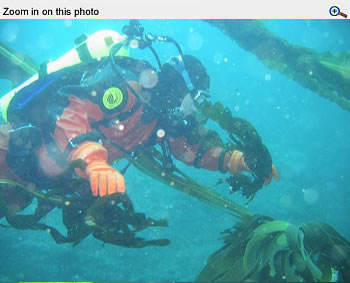
Shawn Harper collects kelp samples for radiation testing near the Cannikin blast site, Amchitka Island. Photo courtesy Stephen Jewett, SFOS.
"The study encompassed several disciplines, and laid a solid foundation for beginning to answer the tough question, which is: are the marine waters around Amchitka and in the Aleutian Chain contaminated by these underground nuclear tests?" Johnson said.
The U.S. Department of Energy funded the $3 million study, organized by the Consortium for Risk Evaluation with Stakeholder Participation (CRESP). Researchers from UAF, Rutgers University, Vanderbilt University, the University of Alberta, the University of Pittsburg, the University of Mississippi, the Institute for Responsible Management and the Robert Wood Johnson Medical School participated in the study.
Scientists undertook an array of geophysical and biological studies on the island and in the waters immediately offshore. On the island, UAF scientists from the Water and Environmental Research Center spent weeks in cramped tents pitched on soggy ground as they braved howling winds and rain to map the myriad faults that dissect the geologically active island. The effort was part of a larger plan to collect a host of data needed to create surface and ground water models. Knowing how groundwater flows across and beneath the island is critical to detecting the first signs of a radiation leak from deep within the island’s blast sites. Researchers also gathered dozens of plant, water and soil samples, as well as rats and seabirds, for later radiation analysis.
At sea, scuba divers from the UAF Scientific Diving Program collected seafloor sediment and water samples, fish, shellfish, kelp and numerous invertebrates such as urchins, sponges and sea stars. The samples would undergo an array of laboratory tests to see if nuclear contamination had reached the marine food web. Stephen Jewett, UAF dive safety officer and research professor of fisheries ecology, led the scuba teams. As a scientist, Jewett has made thousands of dives and has seen much of Alaska’s undersea world. Still, he was awestruck by the undersea beauty of the Aleutian Islands.
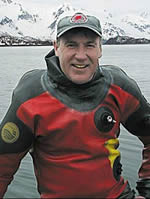
Stephen Jewett is a UAF dive safety officer and research professor of fisheries ecology.
Photo courtesy UAF School of Fisheries and Ocean Sciences.
"The Aleutians are just a spectacular environment," Jewett said. "Of all the places I have dived, I have not found any place quite as unique. It has incredible visibility because there’s virtually no sediment in the water column. We had visibility approaching 100 feet, which is uncharacteristic in most waters of the state. And the diversity of plant and animal life out there is incredible. We saw sponges, soft corals and hydroids. Just unbelievable."
Listen to Stephen Jewett describe diving in the Aleutians.
A team of Aleut Natives accompanied the expedition and assisted in the collection of subsistence foods for radiation analysis. The Aleuts also harvested a Steller sea lion. Steller sea lions are an endangered marine mammal and can only be harvested for subsistence use by Alaska Natives. The hunters kept the meat, while scientists took tissue and organ samples to be tested for nuclear contamination.
Back on the Ocean Explorer, Johnson and his team of UAF and U.S. Navy oceanographers kept busy with efforts to map the ocean floor on the north side of Amchitka Island, where the Cannikin test was conducted. They also used sophisticated sensors in an attempt to locate freshwater seeps that might be bubbling up from fissures running from deep within the island to the surrounding seafloor.
"The likely path of radiation leakage is thought to be freshwater coming down on the island as rain and runoff and percolating down through the blast sites and then slowly seeping, diffusing out underneath the ocean floor and coming up under the ocean," Johnson said.
UAF scientists find no nuclear leaks, but worry about the future
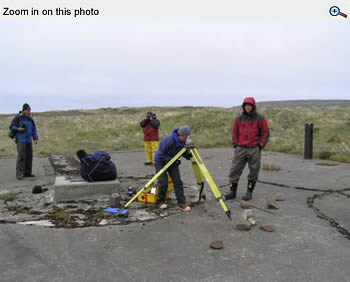
Anna Forsstrom collected global positioning survey (GPS) measurements at the Cannikin site on Amchitka Island. These measurements provided data about deformation of the ground associated with active faulting on and near the island. Observers are, from the left, Martyn Unsworth, Volkan Tuncer and Wolfgang Soyer. Photo by Dan Volz, UAF.
Altogether, scientists collected 3,500 pounds of samples from the terrestrial and marine environments of the island. In the months since the 2004 field work, high-tech labs in New Jersey, Tennessee and Idaho tested the samples for radiation and other nuclear test-related contaminants. In press conferences and town meetings held around coastal Alaska during 2005, study leaders said no radioactivity was found beyond the expected background levels present everywhere on the planet.
"Overall, our geophysical and biological analyses did not find evidence of risk from radionuclides from the consumption of marine foods, nor indication of any current radionuclide-contaminated migration into the marine environment from the Amchitka test shots," CRESP lead scientist Charles Powers said in the team’s report on the study’s findings.
The results were not surprising to Johnson or the other scientists.
"There were no indications of any radioactive leakage, and all that was really wonderful news," said Johnson. "If there had been leakage, it would be a whole new ballgame. But we are delighted to learn that at this time there is no evidence that these blast sites have done anything but contain the radioactive material."
Even so, Johnson said his relief is tempered by what he says is UAF’s obligation to keep a close eye on the island. He said that while nothing was found this time, most scientists believe the island will one day leak potentially deadly radiation. Because Amchitka lies within a geologically active region, where earthquakes and volcanic eruptions are common, a long-term research and monitoring program is essential.
"Most scientists I know are convinced that we need to visit this site every several years," Johnson said. "We are obligated as a species to go there and keep testing and keep looking to understand the implications of what (the nuclear tests) have done and to make sure we haven’t contaminated the environment."
Since this study ended, UAF has launched an ambitious effort with the U.S. Fish and Wildlife Service, the Aleutian Pribilof Islands Association, the Alaska Department of Environmental Conservation and the U.S. Department of Energy to develop a stewardship plan for the island that includes additional research and monitoring.
"This first study provides the state of Alaska and the federal Department of Energy with the kind of information they need to develop a long-term plan for the island," said Dave Barnes, UAF associate professor of civil and environmental engineering, and lead organizer of the UAF study.
For more information, please contact:
-
Doug Schneider, information officer, NOAA Alaska Sea Grant College Program, School of Fisheries and Ocean Sciences, University of Alaska Fairbanks, (907) 474-7449, fndgs@uaf.edu
Other useful links:
- Learn more about the 2004 UAF Amchitka expedition:
- Learn more about Amchitka’s Nuclear past:
- A personal account of the Milrow blast (no longer available online)
- Cannikin Facts
- Counter views of Cannikin Blast:
- http://www.akaction.net/pages/critical/amchitk.html (no longer a good link)
- http://www.lightparty.com/Peace/LegacyNuclearTest.html
- Amchitka Nuclear Worker Compensation Information:
- Nuclear Flashback: Report of a Greenpeace Scientific Expedition to Amchitka Island, Alaska (no longer online)
- Alaska Maritime National Wildlife Refuge
- Aleutian Pribilof Islands Association
- Aleut Native History
- Amchitka and the Bomb: Nuclear Testing in Alaska
- The Firecracker Boys
Study Leaders:
- David Barnes, UAF Water and Environmental Research Center
- Lawrence Duffy, UAF Institute of Arctic Biology
- Joanna Burger, Rutgers University
- David Kosson, Vanderbilt University
- Lisa Bliss, Institute for Responsible Management
- Martyn Unsworth, University of Alberta
- Conrad Volz, University of Pittsburgh
- James Weston, University of Mississippi
- Charles Powers, University of Medicine and Dentistry of New Jersey
UAF Scientists, Graduate Students and Scientific Divers:
- Mark Johnson, UAF
- Stephen Jewett, UAF
- Graduate Students:
- Ann Forsstrom
- Sookmi Moon
- Dive Team:
- Max Hoberg
- Heloise Chenelot
- Shawn Harper


